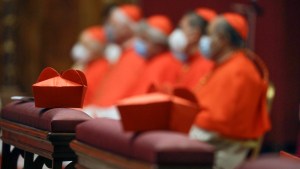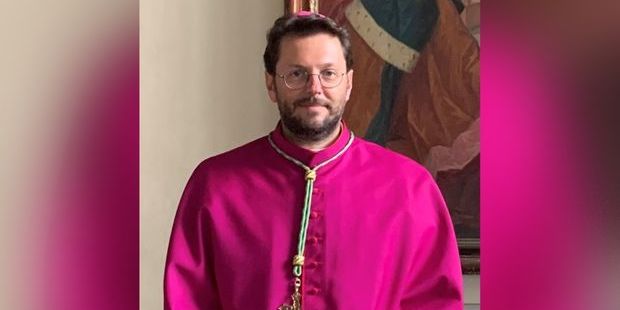Meet the youngest cardinal of the Catholic Church
Cryptopolytech Public Press Pass
Title: Meet the youngest cardinal of the Catholic Church
200000048 – World Newser
•| World |•| Online |•| Media |•| Outlet |
Meet the youngest cardinal of the Catholic Church
The future Cardinal Giorgio Marengo is described by some as a breath of fresh air from the Mongolian steppe.
After becoming the world’s youngest bishop in 2020, in a few weeks he will become the youngest cardinal, and the first to be born in the 1970s. The name of Bishop Giorgio Marengo, 48, Apostolic Prefect of Ulaanbaatar, came as a surprise when Pope Francis pronounced it from the window of the Apostolic Palace after the Regina Caeli prayer on Sunday, May 29.
An Italian national and the first cardinal to represent Mongolia, he has been the subject of much media attention since the announcement, as the year 2022 marks the 30th anniversary of the arrival of the first Catholic missionaries in the Asian country and the establishment of relations with the Holy See. The creation of this new missionary cardinal gives us the opportunity to discover a country rarely placed in the spotlight, and to observe the young face of a Christianity born and developing as a minority but without an inferiority complex.
Born in Cuneo, Piedmont, on June 7, 1974, Giorgio Marengo was ordained a priest in 2001 for the Consolata Missionaries, an Italian congregation founded at the beginning of the 20th century and specializing in accompanying young churches. After obtaining a doctorate in missiology at the Pontifical Urban University in Rome, this former boy scout and fencer set out on an adventure to meet a people who had never heard of Jesus, a figure sometimes difficult to grasp in Asia, where Christianity is generally associated with European colonial history.
Mongolia is landlocked between the Russian and Chinese spheres of influence but has never been reached by European powers. It was therefore in a land free of any prejudice that Fr. Giorgio Marengo settled in the 2000s, sent to Avayheer, a small town of 20,000 inhabitants located in the center of the country, where he founded the parish of Mary Mother of Mercy.
Bringing the Gospel to the heart of Asia
In that first home with his missionary brothers of the Consolata, “we were really like strange Martians from Saturn,” he said humorously during a
testimony given in 2020
at an Italian shrine.
At his first mission community, where no Catholic church had existed before, “people saw us as spies or as emissaries of a state. It took a long time to build relationships, to trust each other, but it’s worth it,” he said.
“People have an attitude of curiosity, of novelty, and sometimes also of suspicion because this reality is not well known, but then there’s an interest, a desire to know,” he told
Telepace
in May 2022. His objective as a missionary is for “the faith to take root deeply” among the Mongolian population.
In 2020, after more than 15 years of missionary work, he was chosen by Pope Francis as apostolic prefect of Ulaanbaatar and was ordained a bishop by Cardinal Tagle, then the prefect of the Congregation for the Evangelization of Peoples (now the Pro-Prefect for the Section of Evangelization of Dicastery for Evangelization). At the time, Bishop Marengo bore witness to the patient, sensitive, and gentle approach with which missionaries are called to “whisper the Gospel in the heart of Asia.” “Being a missionary is not about spreading propaganda or ideology, but making possible a concrete encounter with Jesus for people who otherwise would not have the opportunity,” he explained.
He also expressed his “joy at seeing the Lord act in a mysterious way and bring people to the Church,” giving the example of a 75-year-old Mongolian woman who, after her daughter’s catechumenal journey, came to him in church asking for baptism, without being able to offer any rational argument, but simply because she felt “good with Him,” she said, pointing to Jesus on the cross.
The “courage and determination” of the newly baptized
The baptized who have chosen to follow Christianity live it “with courage and determination,” even if it means seeming “strange, a little outside the choir” and exposing themselves to “opposition and discrimination, even if Mongolia is a democratic country,” explained Bishop Marengo in an interview with Vatican News.
As a sign of the country’s openness, including on the part of Buddhist religious authorities, a Mongolian delegation was received by Pope Francis on May 28, on the eve of the consistory announcement. The Apostolic Prefect of Ulaanbaatar was able to share directly with the pope this astonishing experience of witnessing to the Gospel in a society devoid of any Western reference.
However, the pope did not give him any signal that he would be considered for a cardinalate, and the next day he was completely surprised. “I received the news at the end of the celebration of the Sunday Eucharist of our Missionary Sisters of the Consolata in their general house, and it was a fraternal and unexpected moment,” he told the Vatican media. He expressed his gratitude for “the attention of the successor of Peter for the Church in marginal and small contexts.”
Mongolia, an immense country three times the size of France with a population of only three million, has one of the smallest Catholic communities in the world. After the extinction of Nestorian Christianity, which had spread throughout Central Asia in the first millennium, it was only in 1992, at the beginning of the country’s democratic opening, that the first Catholic missionaries arrived, in a religious context dominated by Tibetan Buddhism.
At present, the local Church has eight parishes and between 1,300 and 1,400 baptized members—a total number much lower than that of most parishes in Bishop Marengo’s home country of Italy, but constantly increasing. The emergence of this Church had interested John Paul II, who wished to go there for the consecration of the cathedral of Ulaanbaatar in 2003, but the visit never materialized.
A strategic gamble with China in mind?
Beyond this attention to the peripheries, geopolitical stakes may also have motivated this choice by Pope Francis. This is the opinion of a Russian expert, expressed shortly after the announcement in an article published by the website Regnum. Mongolia is indeed a buffer country between Russia and China, and, surprisingly, it’s also one of the few countries in the world to maintain regular relations with both the People’s Republic of China and Taiwan, since it was during the Chiang Kai-shek regime, in 1945, that Mongolia’s independence was formally recognized by China.
In the context of the great geopolitical game being played in Asia, the Cardinal of Ulaanbaatar could provide a valuable point of contact for the Holy See with regard to Central Asia, Russia, and the former Soviet zone of influence, and especially with regard to China.
The Chinese government cannot be approached head-on by the Holy See due to the lack of official diplomatic relations and the impossibility of creating a new Chinese cardinal, given, it seems, a clause in the provisional agreement on episcopal appointments signed in 2018 between Rome and Beijing, reports Il Sismografo. The pope’s wish is perhaps to make this small Christian community in the Mongolian steppe a gateway to a Chinese world still unknown and difficult to access, but which could constitute a major pole of development of Catholicism in the decades to come .
Pope Francis’ challenge to decentralize the Sacred College from its European base and to orient it progressively towards the missionary peripheries would thus take on its full meaning. The future will show if the first pope from Latin America was also the one who turned to Asia. Under the pontificate of the Argentinean, who as a young Jesuit dreamed of being sent on mission to Asia, it is this continent that has seen the greatest increase in the number of cardinals represented in the Sacred College, going from 9% in 2013 to 15% today.
If this trend continues in the long term, Cardinal Giorgio Marengo, who will remain an elector until June 2054 and should logically participate in several conclaves, could therefore become a key figure in the great changes of Christianity in the 21st century.

‘News of the Day’ content, as reported by public domain newswires.
Source Information (if available)
It appears the above article may have originally appeared on aleteia.org and has been shared elsewhere on the internet, repeatedly. News articles have become eerily similar to manufacturer descriptions.
We will happily entertain any content removal requests, simply reach out to us. In the interim, please perform due diligence and place any content you deem “privileged” behind a subscription and/or paywall.
First to share? If share image does not populate, please close the share box & re-open or reload page to load the image, Thanks!



